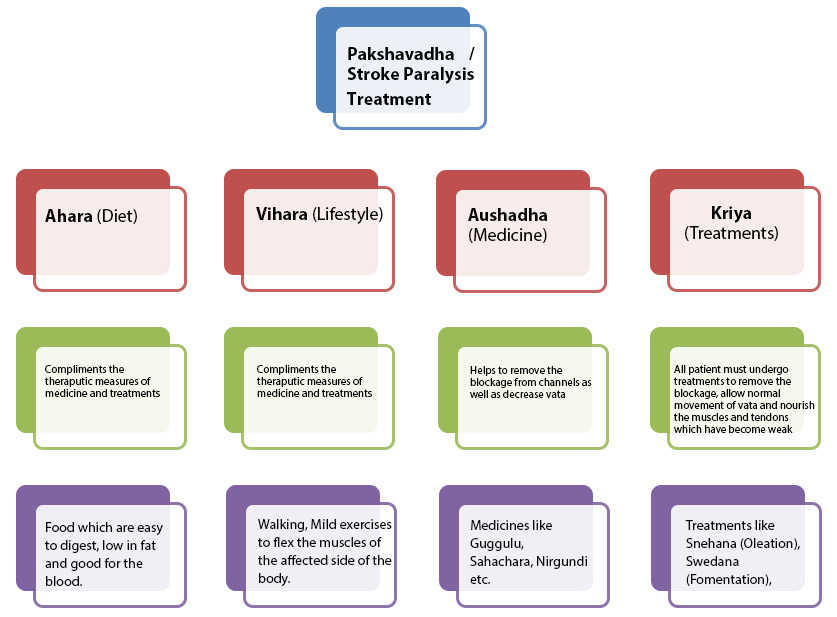
Paralysis & Stroke
Paralysis is one of the most common disabilities following a stroke. The paralysis is usually on the side of the body opposite the side of the brain damaged by stroke, and may affect the face, an arm, a leg, or the entire side of the body. This one-sided paralysis is called hemiplegia if it involves complete inability to move or hemiparesis if it is less than total weakness.
The types and degrees of disability following a stroke depend upon the area of the brain damaged and the extent of damage. Generally, stroke can cause five types of disabilities: Paralysis or problems controlling movement; Sensory disturbances including pain; Problems using or understanding language; Problems with thinking and memory; and Emotional disturbances.
In Ayurveda, the causative factors as well as the development of the disease are explained in a similar manner to Allopathy. However the outcomes of treatment are more successful with Ayurveda medicines and therapy when compared to modern medicine.
Ayurveda states that Pakshavadha develops due to strotorodha(blockage of the channels of blood) which causes obstruction of the normal movement of vata through the body. The blockage usually occurs in the brain (similar to above mentioned development) or obstruction of the nerve pathways. Vata begins to localize in the affected area causing depletion of that area in the brain as well as improper nervous activity. Depending on the severity of the obstruction along with the longer duration, the muscles and tendons of half of the body become weak and depleted.
How does Pakshavadha develop?

AyurVAID Kalmatia’s Approach to Stroke Paralysis
Considering the stage of the paralysis, for how long the patient has had this condition as well as their strength, an optimized treatment plan is formed by our senior physicians. If the paralysis is of a recent onset, then medication such as DhanwantramKashayam etc. is prescribed along with some mild treatments like Abhyanga (Application of medicated oil on the body), or Kaya Seka (pouring of warm medicated oil on the body).
A patient who has had paralysis due to a stroke for longer than one year requires more extensive treatment. This is because half of the body has been inactive for so long that the muscles start to waste away (no longer have strength to function). Hence the treatment plan usually has five stages
1. Medication to prepare the body for internal as well as external Snehana (Oleation)
2. Snehana internally with some medicated oils or ghee + external oleation. (For 3 – 7 days)
3. Swedana (Fomentation – causing sweating) with steam bath etc.
4. Virechana (Purgation) with a medicinal powder or castor oil.
5. Medication to regain strength of muscles as well as overall immunity
Note: Diet and life style activities are essential to the treatment of stroke paralysis but they are not sufficient alone to treat the condition. That is why a specific diet is prescribed to complement the main therapeutic measures.

Comprehensive Stroke Rehabilitation Program
AyurVAID Kalmatia’s Comprehensive Stroke Rehabilitation Program (SRP) is a sub-acute and chronic rehabilitation program for stroke sufferers. It is built on classical Ayurveda treatments that address the aetio-pathogenesis of the CVA (cerebrovascular accident), or stroke, the attendant risk factors and manifestations.
Classical Ayurveda therapies are integrated in synergy with Functional or Occupational therapy inputs to maximize benefits to the patient. To this end, AyurVAID has formulated a specialized integrated protocol to classify cases, assess severity and conjoint risk factors and draw up a thorough medical management plan. This results in a customized rehabilitation for each patient, including internal medication, Ayurveda therapies, functional therapies (either at our hospital or at home by a family member) as well as dietary and lifestyle prescriptions.
SRP Functional Therapy Module Overview
Functional/Occupational Therapy provided under the Stroke Rehabilitation Program uses a combination of two approaches. Neuro-developmental therapy is used to promote and relearn normal movement and to reduce muscle spasticity. It inhibits abnormal reflexes and encourages normal, functional movement patterns. Sensory Integration helps to organize sensations from the body and the environment to aid the patient to make sense of the environment.
Initial Assessment and Outcome Scales
Initial Assessment is carried out according to standard AyurVAID protocol, supplemented by Neurology specific assessment protocol. Aetio-pathogenesis and medical management plan are derived from classical Ayurveda principles. Standardized Outcome scales are used through the Patient Management Cycle. We use the NIH Stroke Scale and the ADL Scale in addition to tracking all vital parameters.
Functional Therapy Modalities
- Normalizing Muscle Tone
- Restoring Active Range of Motion (ROM)
- Mobility and Balance Training
- Improving Gross and Fine Motor Skills & Motor Control
- Perceptual Re-training
- Improving Communication Skills
- Electrical Stimulation
For Customized Packages, email us at: kalmatia@ayurvaid.com


